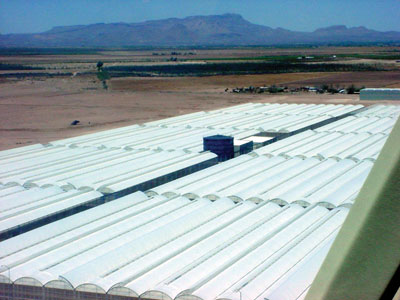
Small greenhouse growers in North America still have opportunities to enter the industry despite the formidable growth in Latin America’s production, according to a University of Arizona professor.
Small greenhouse growers in North America still have opportunities to
enter the industry despite the formidable growth in Latin America’s
production, according to a University of Arizona professor.
Just a few years ago, the greenhouse vegetable industries in Canada and
Mexico were about the same size. Both countries had little more than
800 hectares in production. Today, however, Mexico’s industry boasts
8,834 hectares while Canada has just 1,062 hectares.
 |
|
| Dr. Merle Jensen (photo by Peter Mitham) |
|
 |
|
| Mexican industry continues to expand. (file photo courtesy Mario Steta)
|
While that sounds like daunting competition, University of Arizona
professor emeritus Dr. Merle Jensen soothed the fears of growers
attending the Pacific Agriculture Show in Abbotsford, British Columbia,
earlier this year by noting that approximately half of Mexico’s
greenhouse acreage is in screenhouses rather than the kinds of
greenhouses that exist in Canada.
Screenhouses serve to shelter plants grown in the soil of the sun-baked
Sonoran desert of northern Mexico. (Growers in the Arizona desert, by
contrast, use closed systems and boilers more akin to northern
greenhouses.)
While screenhouses may have facilitated the growth of tomato production
in Mexico by creating a more controlled environment than field
production allows, the Mexico industry’s focus on exports isn’t
necessarily meshing with demands for local produce in many areas of
North America.
LOCAL PRODUCE TRUMPS ORGANIC FOR MANY SHOPPERS
The growth of organic produce was big, Jensen said, but local produce
trumps organic for an even greater number of consumers for a variety of
reasons.
It’s the kind of value B.C. Hot House Foods Inc. highlighted last year
when consumers raised concerns about the company’s use of its
established B.C. Hot House brand on produce it was importing from
Mexico. B.C. Hot House had placed fine print on the labels noting that
the items were grown in Mexico. However, the consumer feedback prompted
B.C. Hot House to develop labels that branded produce from Mexico as
“MX Hot House,” avoiding any confusion in the minds of locavores (as
consumers of local foods have come to be known).
Grocery store produce managers favour local produce over imported
product, he said, because of the relationship they can enjoy with
growers. They’re looking for that connection, and being able to share
it with consumers. Consumers want that relationship, he explained,
because local produce is seen as being of better quality.
“Food safety is a big, big deal,” he said.
Sunizona Family Farms of Willcox, Arizona, one of the farms Jensen
works with, has been able to enjoy a significant advantage by providing
local produce to local grocers.
Small producers who want to become involved in the market have to do
more than provide retailers with a consistent supply of produce, Jensen
explained.
THESE PREMIUM PRODUCTS COMMAND PREMIUM PRICES
Rather than working on volume, Jensen said small growers have the
opportunity to deliver a premium product that commands premium prices.
He pointed to tomatoes at the Union Square farmers’ market in New York,
which can sell for $4.30 US a pound. Those tomatoes are often heritage
varieties that build on the cachet of something different, not just
something local.
Jensen said that growers who produce for niche markets have to accept
the fact that hours will be long, however. The grower who sells at the
Union Square market doesn’t usually get home till 10 p.m., he noted.
The challenges of labour are shared by other players in the industry,
too, particularly in the desert borderlands of Arizona and Mexico.
While growers in Arizona can capitalize on migrant workers from Mexico,
Jensen said some are illegal immigrants. Producers in Sonora, Mexico,
on the other hand, are always scrambling for workers because labour is
usually just stopping over on the way to the U.S.
MEXICO'S INDUSTRY ALSO FACING MAJOR CHALLENGES
Jensen said Mexico’s industry also faces some particular challenges,
particularly around disease and pest control. Without a winter cold
snap, growers must work with biological controls to prevent and manage
outbreaks. Similarly, vine hygiene is also important.
Jensen believes the lack of a collaborative environment in Mexico is an
obstacle to more rapid growth. He contrasted that with the co-operative
approach growers in Guatemala are taking. Guatemala’s farmers are
ramping up production in a big way, with shipments making their way
across the Gulf of Mexico to stores in Texas and elsewhere.
Peter Mitham is a freelance writer and photographer in British Columbia.
Print this page